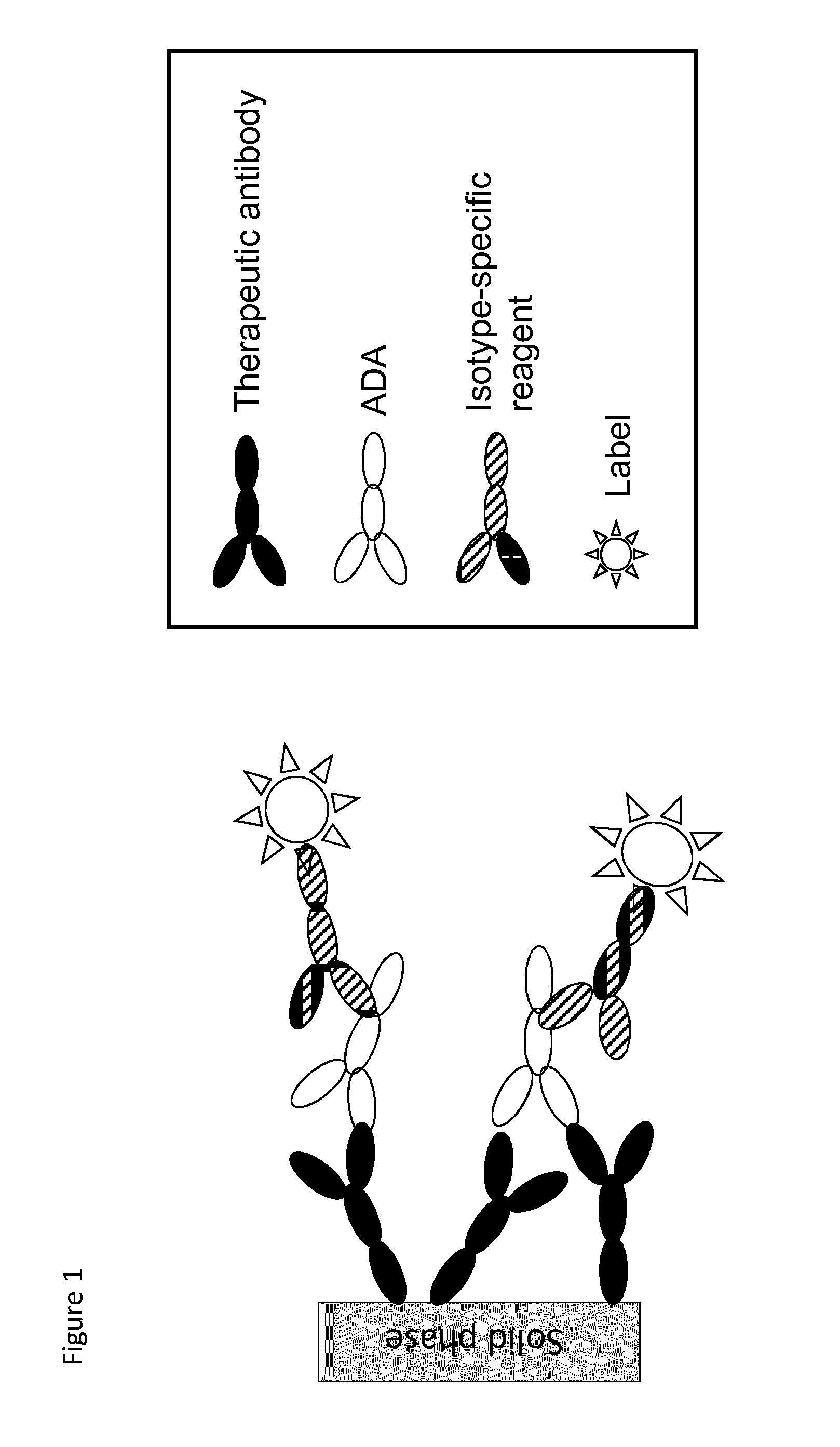Analysis of antibodies
an antibody and antibody technology, applied in the field of biochemical analysis, can solve the problems of adverse reactions, interference of total immunoglobulin, and not all patients respond as expected to biological drugs, and achieve the effect of reducing nois
- Summary
- Abstract
- Description
- Claims
- Application Information
AI Technical Summary
Benefits of technology
Problems solved by technology
Method used
Image
Examples
example 1
Assay Interference Caused by Fc-Fc Interactions
[0086]One example of assay interference dedicated Fc-Fc interactions can be shown using therapeutic antibodies with the human IgG1 Fc domains of infliximab (a chimeric monoclonal antibody against tumour necrosis factor alpha (TNF-α) used to treat autoimmune diseases, also known as Remicade and available e.g. from JANSSEN BIOTECH INC) or adalimumab (HUMIRA (“Human Monoclonal Antibody in Rheumatoid Arthritis”), available e.g. from Abbott Labs) coupled to experimental ImmunoCAP™ tests and used in the commercial ImmunoCAP™ Specific IgG4 assay (available through www.phadia.com). The assay has an enzyme-conjugated mouse monoclonal antibody against human IgG4 as detection reagent. The detection antibody has no apparent cross-reactivity to human IgG1 (data not shown). The therapeutic antibodies are covalently coupled to the solid phase using reactive amino-groups of the therapeutic antibody and CNBr-activated groups of the cellulose sponge matr...
example 2
Coupling of Infliximab to Solid Phase with and without Linker
[0087]The length and nature of the linker has to be optimized for each solid phase and IgG molecule. The linker should be optimized for low assay background levels and preserved high signal-to-noise ratio for positive samples.
[0088]This example shows the effect of using linkers for the attachment of an IgG molecule to a solid phase of an antibody immunosorbent assay, and the results are presented in FIGS. 5 and 6.
[0089]The FIG. 5 presents results from an experiment using infliximab (IFX), a therapeutic antibody of IgG1 isotype (also known as Remicade, available e.g. from JANSSEN BIOTECH INC) attached according to the invention to a solid phase of ImmunoCAP™ (available through www.phadia.com) via a linker based on the streptavidin / biotin coupling system and via a linker based on its ligand, tumor necrosis factor alpha (TNF-α). Direct coupling of infliximab to the solid phase results in high backgrounds in the ImmunoCAP™ Spe...
example 3
Variation of the Size of the Linker
[0091]Linkers of different sizes were provided and tested in an infliximab assay according to the invention. The results are presented in Table 2 below:
TABLE 2Specific IgG4 assay results, infliximab(Response units)MW ofPositiveNegativeNegativeMean of NegativeRatioLinkerlinkersamplesample 1sample 2sample 1 and 2Pos. / Neg.No linkerN / A196156574862976022.6Streptavidin53 kDa2297635442038759.4HSA67 kDa1650426531729156.7PAMAM dend. gen. 414 kDa2321546256351345.3PAMAM dend. gen. 00.5 kDa 2209635847841852.9Abbreviations:MW = Molecular weightN / A = Not applicableHSA = Human serum albuminPAMAM dend. gen. 4 = PAMAM dendrimer generation 4PAMAM dend. gen. 0 = PAMAM dendrimer generation 0
PUM
| Property | Measurement | Unit |
|---|---|---|
| concentration | aaaaa | aaaaa |
| structure | aaaaa | aaaaa |
| surface | aaaaa | aaaaa |
Abstract
Description
Claims
Application Information
 Login to View More
Login to View More - R&D
- Intellectual Property
- Life Sciences
- Materials
- Tech Scout
- Unparalleled Data Quality
- Higher Quality Content
- 60% Fewer Hallucinations
Browse by: Latest US Patents, China's latest patents, Technical Efficacy Thesaurus, Application Domain, Technology Topic, Popular Technical Reports.
© 2025 PatSnap. All rights reserved.Legal|Privacy policy|Modern Slavery Act Transparency Statement|Sitemap|About US| Contact US: help@patsnap.com



